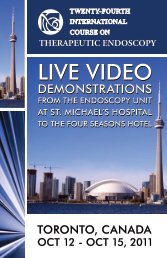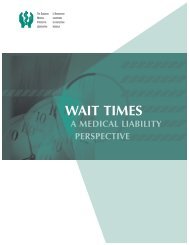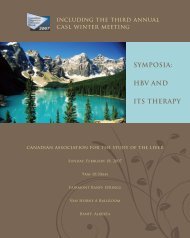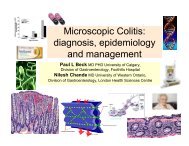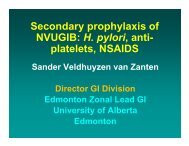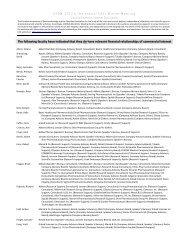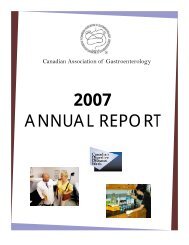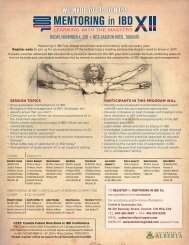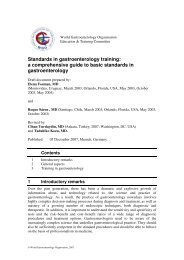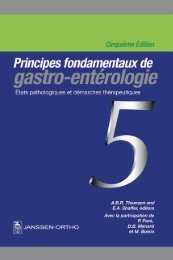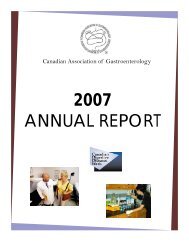Manifestations of Gastrointestinal Disease in the Child
Manifestations of Gastrointestinal Disease in the Child
Manifestations of Gastrointestinal Disease in the Child
You also want an ePaper? Increase the reach of your titles
YUMPU automatically turns print PDFs into web optimized ePapers that Google loves.
690 FIRST PRINCIPLES OF GASTROENTEROLOGY<br />
kidneys). A child who presents with persistent bile-sta<strong>in</strong>ed emesis requires an<br />
upper GI contrast study to exclude anatomical causes <strong>of</strong> obstruction <strong>in</strong>clud<strong>in</strong>g<br />
<strong>in</strong>test<strong>in</strong>al malrotation, webs, r<strong>in</strong>gs and strictures. The contrast study may<br />
<strong>in</strong>clude a follow-through <strong>of</strong> <strong>the</strong> small <strong>in</strong>test<strong>in</strong>e to identify more distal problems<br />
such as term<strong>in</strong>al Crohn’s disease.<br />
2.1.4.3 Microbiology<br />
Ur<strong>in</strong>alysis is important to exclude ur<strong>in</strong>ary pathology such as <strong>in</strong>fection. Stool<br />
exam<strong>in</strong>ations for bacterial culture, ova and parasites, and viruses are <strong>in</strong>dicated<br />
if diarrhea is present, and for Clostridium difficile tox<strong>in</strong> if <strong>the</strong>re is a recent<br />
history <strong>of</strong> antibiotic use. In <strong>the</strong> severely ill and/or febrile child with emesis<br />
and suspected sepsis or men<strong>in</strong>gitis, cultures <strong>of</strong> <strong>the</strong> blood and cerebrosp<strong>in</strong>al<br />
fluid are required.<br />
2.1.4.4 Endoscopy<br />
Upper gastro<strong>in</strong>test<strong>in</strong>al endoscopy may be employed to exclude mucosal disease<br />
<strong>in</strong> <strong>the</strong> esophagus (esophagitis), stomach (H. pylori gastritis, ulceration)<br />
or duodenum (ulceration, Crohn’s disease, celiac disease).<br />
2.1.5 CYCLIC VOMITING SYNDROME<br />
A group <strong>of</strong> children present with recurrent severe discrete episodes <strong>of</strong> vomit<strong>in</strong>g<br />
<strong>in</strong> which <strong>in</strong>vestigations reveal no organic cause. These children are diagnosed<br />
with cyclic vomit<strong>in</strong>g syndrome (CVS). Given <strong>the</strong> broad differential diagnosis <strong>of</strong><br />
this type <strong>of</strong> vomit<strong>in</strong>g, <strong>in</strong>clud<strong>in</strong>g many surgical and metabolic entities, CVS is<br />
considered to be a diagnosis <strong>of</strong> exclusion.<br />
This entity is characterized by:<br />
1. Recurrent severe discrete episodes <strong>of</strong> vomit<strong>in</strong>g<br />
2. Vary<strong>in</strong>g <strong>in</strong>tervals <strong>of</strong> normal health <strong>in</strong> between episodes<br />
3. Duration <strong>of</strong> vomit<strong>in</strong>g episodes last<strong>in</strong>g from hours to days<br />
4. No apparent cause <strong>of</strong> vomit<strong>in</strong>g (negative laboratory, radiographic,<br />
endoscopic test<strong>in</strong>g)<br />
The episodes tend to be stereotypical and self-limited. Events are usually <strong>of</strong><br />
rapid onset, <strong>of</strong>ten start<strong>in</strong>g dur<strong>in</strong>g sleep or <strong>in</strong> <strong>the</strong> early morn<strong>in</strong>g. The episodes<br />
may persist for hours to days and may be separated by symptom-free <strong>in</strong>tervals.<br />
Associated symptoms may <strong>in</strong>clude lethargy, nausea, abdom<strong>in</strong>al pa<strong>in</strong>,<br />
headache, and, less frequently, motion sickness and photophobia. <strong>Child</strong>ren<br />
may be pale and, with less frequency, may have o<strong>the</strong>r signs <strong>in</strong>clud<strong>in</strong>g diarrhea<br />
and fever. They may have severe abdom<strong>in</strong>al pa<strong>in</strong> that can mimic an acute<br />
abdomen. Various trigger<strong>in</strong>g events have been described <strong>in</strong>clud<strong>in</strong>g psychological<br />
stress, <strong>in</strong>fections, dietary and hormonal (menses).



